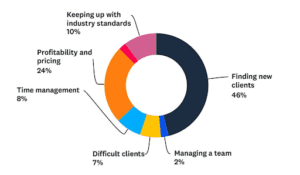6 things you need to know when becoming a Website Designer
approx 5 minute read
There is no doubt that more and more businesses are prioritising their online presence. Although that trend was predicted as far back as 2010 and has been increasing year on year, (check out this study by Deloitte) Covid-19 has certainly been the catalyst for more companies, big and small, taking the relevant steps to ensure they can be found online. Indeed, the global brand partnership for creatives, Nettl, has seen more website projects deployed throughout the network over the past 2 months than ever before. And many of those projects have been built by graphics businesses who, 3 months ago, never offered website design as a service.
Being able to offer website design is clearly an advantage. Whether you insource it, or outsource it (here’s a run through of the pros and cons of outsourcing web design) it is an in-demand product. That word, product, is important. Because website design isn’t a product that is ‘one size fits all’. And becoming a website designer has far more considerations than ‘design’. There are so many factors to consider when deciding to say yes to web projects. In this article, we will look at the 6 most important things to consider when becoming a website designer and agreeing to take someone’s presence online.
1. What’s Your Market?
According to this article published in Forbes magazine, the number one element to consider when launching a new product is defining your target audience. When starting out as a web designer, you might be tempted to only target corporate businesses or ‘blue-chip’ companies. That is appealing, those types of companies tend to have bigger budgets than your local SME. However, we need to consider the work associated with web projects that are say, £10k plus. Are they more likely to contain project creep, more susceptible to change as the project goes on? (If you don’t know that term yet, you will soon. Project creep is like your Aunt Mildred talking at a family Christmas party. She goes on, and on, adding embellishments to the story that were never there to begin with, leaving you to make sense of a changing tale). Big budgets mean big expectations. And by that I don’t mean high standards. Even the hair salon down the road with a budget of £800 has high standards that should be met. But inflated expectations could equal complex functionality. Coding, PHP, something ‘very bespoke’. These are all fine if you’re aware of them from the start. But that’s hard to manage when you’re first starting out (and have not made your own mistakes to learn from)!
Take a look at this Market Pyramid from Nettl. It acts as a guideline for Nettl partners who are starting out selling web as to where the web ‘sweet-spot’ is, the most lucrative area of the market. Nettl thinks that, especially graphic designers turned web designers, should concentrate on projects based between £500 and £10,000. In a podcast interview, Lauren Okruch, from the Nettl of Dublin store, advised though, that she would “prefer to manage 10 x £1,000 websites than 1 x £10,000 website in order to prevent project creep and to ensure profitability across each project”. By following something similar to the Nettl Market Pyramid it’s likely that you would work with a variety of SME companies, be they businesses who need a website revamp or an entrepreneur who requires something from scratch.
2. Price, Price, Price
Demographic and pricing are interlinked. Katherine Paine was right when she said “the moment you make a mistake in pricing, you’re eating into your reputation or your profits.”* When you start offering website design, it’s helpful to know what hourly rate your business needs to be profitable. For example, a rate between £50 and £100 an hour. A £1,000 site might therefore take you 10 hours to complete, a basic brochure site priced at £300 just 3 hours. It’s easy to understand then, why one would prefer to take on 10 x £1,000 sites than 1 x £10,000 site. There’s not much room in 10 hours for back and forth and the smaller the risk of project creep, the smaller the risk of the project becoming unprofitable.
Another tip when starting out in web is looking at how and when a client should pay. One of the Nettl Mantras (and there are a few of those) is to charge based on time rather than deliverables. For example, say you advise a client that you will take a deposit now and stage 2 of the payment plan will be collected once the homepage has been finalised. But if the client is providing the content for the homepage, and stalls giving it to you, you aren’t going to get paid. Instead, let’s say you take a deposit now and stage 2 of the payment plan will be taken in 4 weeks time. This means regardless of how and when the client provides you with content, you’re still going to get paid and cashflow isn’t an issue. It might also give your client that bit of impetus to give you the copy too! It helps to keep the project on track. You might want to look at automating your payments to make life even easier. Have a read of Secrets & Chandeliers to get some ideas.
3. Which Platform is Best?
This is a good question. And an important one. Different platforms are good at doing different things. Most web designers, especially when starting out in web, pick one or two that they like and get to know them inside out. The world of web is constantly evolving and platforms are regularly updated to reflect new client demands and trends. Many platforms will give you time to try them out for free but it’s good to do some research into what you think you will like working with. If you come from a graphic design background you’re probably looking for something that doesn’t require PHP or CSS knowledge. And that doesn’t mean you’ll be stuck with templates. Take WordPress for example. Its market share is 37% of all websites** but it attracts a wide range of skill-sets. From devs who code from scratch to designers who use a theme builder, there’s something for everyone. And as platforms become more design friendly, they substitute the need to produce photoshop mock-ups which saves time and money.
4. Who You Gonna Call?
With everything new, there’s always a learning curve. Web design isn’t something that can be mastered overnight. But it’s worth thinking about how you’ll tackle those questions that you don’t know the answer to. Each platform, like WordPress, has its own bank of online resource and there are numerous forums on which you can post queries and glean information. If you’re an independent business owner and work solo, take the time to think about how far you will go to do something unknown. Constantly up-skilling yourself is great but it can’t be done at the risk of making a project unprofitable, stressful or, worst case scenario, undoable. Partnerships like Nettl have internal teams of ‘geeks’ who can be called upon to provide tech support when needed. Looking to learn more about Nettl partners, you should have just said!
5. SEO
Stable WP considers SEO a strong investment in 2020 and an investment that will remain valuable. More and more clients understand the importance of being found online, especially due to Covid-19 when the entire world was forced to rethink how they do business. How they shop. How they communicate. And in order to compete, money needs to be spent on SEO. So the more website design you offer, it’s likely that more and more people will ask you about SEO. Some creatives outsource it, some try their hand at learning it themselves. Whichever your route to market, SEO needs to be considered. And remember, it’s monthly recurring revenue so definitely not something to be sniffed at. Look to the future when starting your web design journey. Once you set sites live, how will you help your clients promote their sites and drive traffic and conversions?
6. Get Your Marketing On Fleek
Circling back to the beginning of this article, we talked about website design as a product. And top tip number 2 on the Forbes piece we looked at earlier is “Know How To Reach Your Audience”. Relevant, engaging and continuous marketing helps you to stay at the forefront of your client’s minds. According to hubspot, the biggest pain point for web designers is attracting new clients – see image below. Websites can be time consuming, especially at the beginning. Without realising, months go by without a piece of your own marketing going out. Clients come first and you fall down the priority list. Don’t let that happen. Come up with a marketing plan that you can add into your daily routine. 15 minutes here, 30 minutes there. And stick to it. Listen to Lauren, Studio Manager from Nettl of Dublin, talk about her own experiences when starting out with web for the first time in this podcast interview. We promise it will make all the difference when you take your first steps in offering web design!
Image source: https://www.sitejet.io/en/article/web-design-statistics-2020
*https://www.priceintelligently.com/blog/bid/182007/6-must-read-pricing-strategy-quotes
If you’re in the graphics, signs and print industry and are looking to grow your offering with web design, Nettl partners can help you begin your journey with marketing, training and custom built CRM systems to make your dream a web design reality. Take a read here to learn more or drop a message to our Nettl team.
If you’re a local business owner looking to grow your business, through web presence, digital marketing or through branding, marketing, design, print and signs, grab a coffee with your local Nettl studio to learn more about what you can do to get more customers




